The layouts featured below appeared at our 2019 exhibition in a total of nine different scale/gauge combinations.
Axmouth (OO)
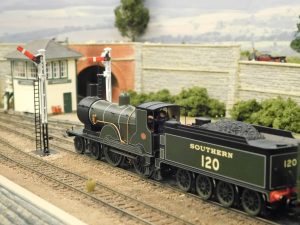 Axmouth is the result of a holiday in Devon and researching the network of ex-LSWR/SR lines in the east of the county. Although we are mainly BR-Blue modellers, an SR liveried Hornby M7 was purchased (a lovely model) so a layout was needed to run it on. The track plan of the terminus at Seaton offered good operating potential; main platform, bay, engine shed and goods yard. This also had an interesting location right alongside the river estuary. However rather than simply follow this plan, we have made Axmouth a ‘mirror-image’ to place it on the opposite bank – the name Axmouth was chosen as it sounds suitable railway-like and the river it is next to is the Axe. Other SR stock was added to the fleet so the setting for Axmouth is in the late-1930’s. The two baseboards are 18″ x 36″ giving a 6′ scenic length so the Seaton plan needed to be compressed – the real thing could accommodate quite long holiday trains. However, the main platform can still take a three coach branch train plus a T9. The buildings are from the Bachmann ‘Shillingstone’ range and add nicely to the SR country feel. We both have an interest in SR EMU’s so Axmouth has been given 3rd rail but just into the bay – this is part of an SR test for rural electrification. Had the second world war not intervened, much more of the ex-SR lines would have been electrified. Anyway it is an excuse to run the superb Hornby 2-Bil. Track is Peco Code 75 for speed of construction, and although we are committed DCC enthusiasts, Axmouth is DC.
Axmouth is the result of a holiday in Devon and researching the network of ex-LSWR/SR lines in the east of the county. Although we are mainly BR-Blue modellers, an SR liveried Hornby M7 was purchased (a lovely model) so a layout was needed to run it on. The track plan of the terminus at Seaton offered good operating potential; main platform, bay, engine shed and goods yard. This also had an interesting location right alongside the river estuary. However rather than simply follow this plan, we have made Axmouth a ‘mirror-image’ to place it on the opposite bank – the name Axmouth was chosen as it sounds suitable railway-like and the river it is next to is the Axe. Other SR stock was added to the fleet so the setting for Axmouth is in the late-1930’s. The two baseboards are 18″ x 36″ giving a 6′ scenic length so the Seaton plan needed to be compressed – the real thing could accommodate quite long holiday trains. However, the main platform can still take a three coach branch train plus a T9. The buildings are from the Bachmann ‘Shillingstone’ range and add nicely to the SR country feel. We both have an interest in SR EMU’s so Axmouth has been given 3rd rail but just into the bay – this is part of an SR test for rural electrification. Had the second world war not intervened, much more of the ex-SR lines would have been electrified. Anyway it is an excuse to run the superb Hornby 2-Bil. Track is Peco Code 75 for speed of construction, and although we are committed DCC enthusiasts, Axmouth is DC.
Photo © S Saxby
back to top
Cheadle Ridge Lane TMD (OO: 4mm scale, 16.5mm gauge)
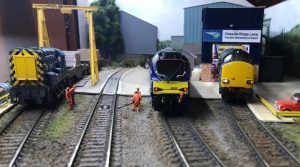 Cheadle Ridge Lane is a fictional depot on the outskirts of Stockport, originally a Network Rail outpost of Buxton depot, it is now managed by DRS. The rolling stock is varied, though dominated by class 37s and 31s with a few others thrown in for good measure, including a route learning bubble car and a parcels DMU for fuel! Short trip workings of steel, ballast, logs, fuel delivery are common and even a flask train, which all usually have a loco change involving a shunt with a class 08 loaned in from Longsight depot.
Cheadle Ridge Lane is a fictional depot on the outskirts of Stockport, originally a Network Rail outpost of Buxton depot, it is now managed by DRS. The rolling stock is varied, though dominated by class 37s and 31s with a few others thrown in for good measure, including a route learning bubble car and a parcels DMU for fuel! Short trip workings of steel, ballast, logs, fuel delivery are common and even a flask train, which all usually have a loco change involving a shunt with a class 08 loaned in from Longsight depot.
Photos © S Lindley
back to top
Chelfham (OO9: 4mm scale, 9mm gauge)
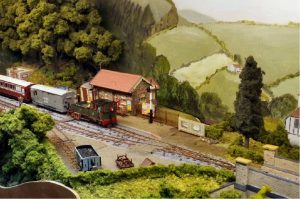 It is early summer in North Devon, and a succession of mixed trains cross the iconic 70ft high Chelfham Viaduct, stopping at the adjacent station in its leafy glade high on the wooded hillside – one of the regular passing places on the famous Lynton & Barnstaple 2ft gauge line. From time to time, a diminutive coal wagon is hand-shunted into or out of the short siding by the fireman and porter/signalman.
It is early summer in North Devon, and a succession of mixed trains cross the iconic 70ft high Chelfham Viaduct, stopping at the adjacent station in its leafy glade high on the wooded hillside – one of the regular passing places on the famous Lynton & Barnstaple 2ft gauge line. From time to time, a diminutive coal wagon is hand-shunted into or out of the short siding by the fireman and porter/signalman.
Chelfham is actually four layouts in one, since it can, and will, be displayed in two different periods (1910-25 in L&B format, and 1930s Southern Railway) each day and viewed from the other side on the second day of the exhibition.
Photos © B Barnard
back to top
Clarendon & Scrubbs Lane (P4: 4mm scale, 18.83mm gauge)
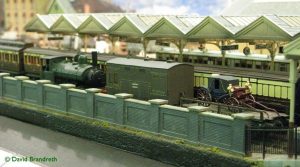 In the early years of the 20th century Addison Road in West London was served by four railway companies, the LNWR, GWR, LBSCR, and LSWR. All four ran trains to the station to allow passengers to cross London from north to south or vice versa with but one change of train. However it was a large station, so we imagined that the LNWR built a spur to a compact terminal station.
In the early years of the 20th century Addison Road in West London was served by four railway companies, the LNWR, GWR, LBSCR, and LSWR. All four ran trains to the station to allow passengers to cross London from north to south or vice versa with but one change of train. However it was a large station, so we imagined that the LNWR built a spur to a compact terminal station.
As Clarendon approached completion, we agreed to move back up the branch to Scrubbs Lane, which would have carriage sidings, small coal yard, goods loop and exchange sidings with a private line to an off-stage gasworks. This was to achieve more interesting working and more authentic workings for passenger traffic with re-making of trains typical of the Edwardian era.
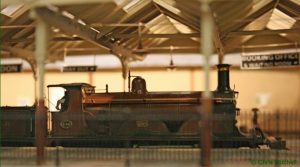 The hand-built track is complemented by full point rodding and working signals. The buildings are constructed of wood, card, and plastic card in various combinations, with some Howard Scenics kits and Scalescenes. The main station building and station-master?s house are based on local (and still existing) relics from the railway in West London.
The hand-built track is complemented by full point rodding and working signals. The buildings are constructed of wood, card, and plastic card in various combinations, with some Howard Scenics kits and Scalescenes. The main station building and station-master?s house are based on local (and still existing) relics from the railway in West London.
The operation of the layout is designed around separate drivers and signalman. The signalman will set the road and the signals, and the drivers will then drive to the signals.
Photos © A York
back to top
Hartley Poole (N: 2mm scale, 9mm gauge)
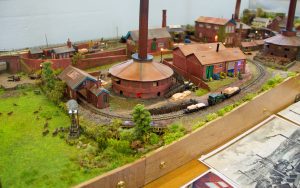 Hartley Poole is set in Somerset in the years between the end of the Second War and the nationalisation of Britain’s railways.
Hartley Poole is set in Somerset in the years between the end of the Second War and the nationalisation of Britain’s railways.
At the east end of the layout is the William Thomas brickworks at Poole, whose sidings gave on to the main GWR line from Bristol and Paddington to Exeter and Penzance. From Poole the mainline runs west, past the Grand Western Canal at the Nynehead boat lift, to Wellington with its platforms, sidings and goods shed (the only feature that survives today). Farther west the line runs up Wellington Bank to enter Whiteball tunnel, the eastern portal being in Somerset; trains emerge from the western portal off-scene in Devon.
The owner/builder of Hartley Poole was born in the signalman’s cottage in Poole, where his grandfather was the signalman. His father was the engineer-fitter for the brickworks.
Photos © A York / BRM
back to top
Hazelwood Junction (N: 2mm scale, 9mm gauge)
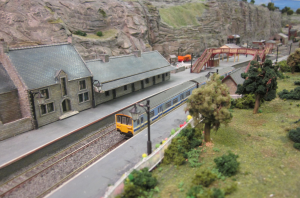 Hazelwood Junction is based on several stations in north east Derbyshire, including New Mills Central, Disley and Hazel Grove. It includes the station buildings from New Mills and also the cliffs which can be found on the nearby Sett trail. The layout uses rolling stock of the late steam and early diesel era. Full details of the construction of the layout, and more pictures, can be found elsewhere on the Society website.
Hazelwood Junction is based on several stations in north east Derbyshire, including New Mills Central, Disley and Hazel Grove. It includes the station buildings from New Mills and also the cliffs which can be found on the nearby Sett trail. The layout uses rolling stock of the late steam and early diesel era. Full details of the construction of the layout, and more pictures, can be found elsewhere on the Society website.
Photos © W Pugh
back to top
Kings Park (N: 2mm scale, 9mm gauge)
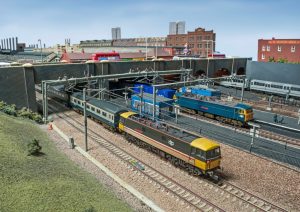 Kings Park is based on a location in the north west of London on the West Coast Main Line from Euston and is set in the 1980s when both BR corporate blue and early sectorisation liveries were to be seen. In addition to the four main line BR tracks with their overhead line equipment, the layout also includes sections of the Bakerloo underground line and the Watford overground, together with the entrance to Willesden loco depot.
Kings Park is based on a location in the north west of London on the West Coast Main Line from Euston and is set in the 1980s when both BR corporate blue and early sectorisation liveries were to be seen. In addition to the four main line BR tracks with their overhead line equipment, the layout also includes sections of the Bakerloo underground line and the Watford overground, together with the entrance to Willesden loco depot.
Photos © Model Rail
back to top
Kozel Cement (HO: 3.5mm scale,16.5mm gauge)
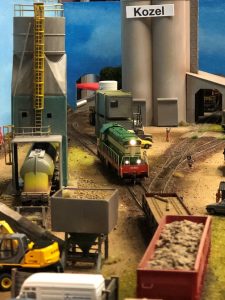 Kozel Cement is an HO layout of a modern Czech industrial unit and is modelled as an inglenook shunting layout.
Kozel Cement is an HO layout of a modern Czech industrial unit and is modelled as an inglenook shunting layout.
Originally conceived by Alan Wardman, the present owner purchased it in 2018, and set to work tweaking the layout, which included revamping the scenery, adding a number of new details and extending the layout by 18″ to give a larger headshunt, which helps the movement of wagons from one side of the inglenook to the other. After many years of being a straight cement works, Kozel has now been given a set of offices and some covered storage for bagged and palletised loads.
Kozel is set in the mid 2000s with a mixture of Czech (CD Cargo and CD) cement trains as well as some from other operators including DB ( Deutsch Bahn). Most common Czech classes of diesel loco are catered for as well as some less common, and a few private locos, including the works own V15 shunter.
Some visitors may recognise the name “Kozel”. It’s a well known and popular brand of Czech beer.
Photos © D Paylor
back to top
Bricksville (L gauge)
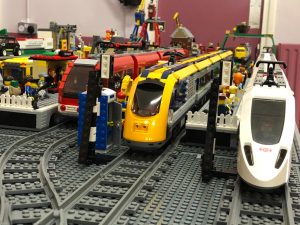 Welcome to Bricksville, a small demonstration layout designed to show the great potential of L gauge for children. This is an interactive display and public participation is welcome from visitors of all ages to help drive the trains – and if the trains crash, just rebuild them!
Welcome to Bricksville, a small demonstration layout designed to show the great potential of L gauge for children. This is an interactive display and public participation is welcome from visitors of all ages to help drive the trains – and if the trains crash, just rebuild them!
L Gauge is an ideal introduction to the world of model railways especially for those seeking to build a layout with a younger family member.
Photos © R Grace
back to top
Maristow (O: 7mm scale, 31.5mm gauge)
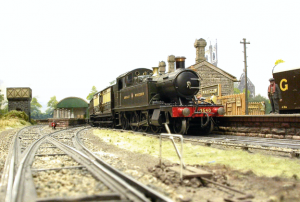 Maristow is a small village on the Devon bank of the Tamar, a few miles north of Plymouth, at the end of a short branch line from Coldrennick Road. One of the Duke class 4-4-0 locos was named after the town. The railway is, of course, imaginary, but tries to recreate a West Country scene around 1900, when the evidence of the recent (1892) conversion from the Broad Gauge is still very obvious. Specific items are the longitudinal track (the ?baulk road?) recently narrowed from 7ft gauge, the Broad Gauge clearances on the bridge and tunnel (with the track offset through the bridge after one rail was slewed over on conversion), the height of the platforms and the non-independent rotating ground signals. We have had much help from the Broad Gauge Society in getting the details right for this type of prototype.
Maristow is a small village on the Devon bank of the Tamar, a few miles north of Plymouth, at the end of a short branch line from Coldrennick Road. One of the Duke class 4-4-0 locos was named after the town. The railway is, of course, imaginary, but tries to recreate a West Country scene around 1900, when the evidence of the recent (1892) conversion from the Broad Gauge is still very obvious. Specific items are the longitudinal track (the ?baulk road?) recently narrowed from 7ft gauge, the Broad Gauge clearances on the bridge and tunnel (with the track offset through the bridge after one rail was slewed over on conversion), the height of the platforms and the non-independent rotating ground signals. We have had much help from the Broad Gauge Society in getting the details right for this type of prototype.
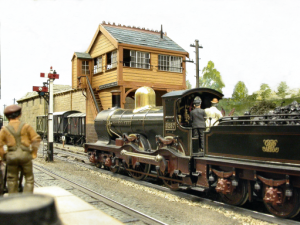 The station has full signalling, with the points, signals and electrical current mechanically interlocked so that the current to the trains is only switched on when the route is correctly set up and signalled. The rolling stock is all from the 1900-1914 period, and the buildings, are scratchbuilt, mostly in Plastikard from various West Country prototypes, particularly Abbotsbury and Perranwell. Most of the excellent scenic detail is the work of Bob Deakin.
The station has full signalling, with the points, signals and electrical current mechanically interlocked so that the current to the trains is only switched on when the route is correctly set up and signalled. The rolling stock is all from the 1900-1914 period, and the buildings, are scratchbuilt, mostly in Plastikard from various West Country prototypes, particularly Abbotsbury and Perranwell. Most of the excellent scenic detail is the work of Bob Deakin.
For those interested in the technical details, the standard gauge stock is built to fine scale standards, and all locos and coaches are fully sprung with a Cleminson arrangement on the 6 wheel coaches that enables them to go round 4½ft. radius curves. Wagons are all compensated, but I may try springing them as well in future. I have standardised on Portescap RG7 motors, with split axle pick up, powered by custom built Controllers. I developed the automatic couplings some years ago to be robust, cheap, easy to make, relatively unobtrusive, and extremely reliable. Hopefully this all adds up to smooth and reliable operation, (but the humans in the system will still probably foul it up somewhere!).
Photos © Tony Wright / BRM
back to top
Marx Engels Platz (N: 2mm scale, 9mm gauge)
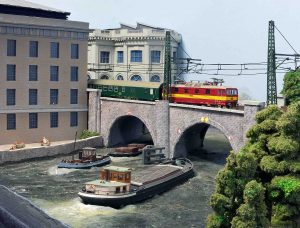 Berlin, spring 1990. It is just over six months since the fall of the Berlin Wall but in this corner of former East Berlin little has changed. The building work which will transform the former east has yet to begin in earnest and there is evidence of the decay of the former capital of the Deutsche Demokratische Republic (DDR) is everywhere.
Berlin, spring 1990. It is just over six months since the fall of the Berlin Wall but in this corner of former East Berlin little has changed. The building work which will transform the former east has yet to begin in earnest and there is evidence of the decay of the former capital of the Deutsche Demokratische Republic (DDR) is everywhere.
The layout attempts to capture the scene at the S Bahn station of Marx Engels Platz (today Häckesche Markt) which is situated in former East Berlin between Alexanderplatz and Friedrichstrasse stations. The line leaves Alexanderplatz station on the right and travels through Marx Engels Platz before crossing the river Spree onto the Museumsinsel and passing between the Natural History Museum and the Pergamon Museum. The two lines towards the rear of the layout are used by the Stadtbahn, a local commuter line whose extensive network covers the whole of Berlin, whilst the double track towards the front of the layout are the interzonal lines allowing trains to cross West Berlin before continuing to their destinations in East Germany and beyond. Trams operate at street level at both Marx Engels Platz and Alexanderplatz stations.
Photos © Derek Shore
back to top
Moormead Sidings (G: 12mm scale, 44.5mm gauge)
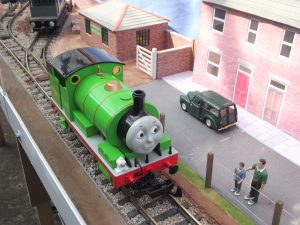 Moormead is a shunting yard somewhere on the Isle of Sodor where the younger visitors can drive Thomas and his friends and get them to assemble the goods trains in the right order.
Moormead is a shunting yard somewhere on the Isle of Sodor where the younger visitors can drive Thomas and his friends and get them to assemble the goods trains in the right order.
Photos © P Dibben
back to top
Moorton Bottom Yard (OO9: 4mm scale, 9mm gauge)
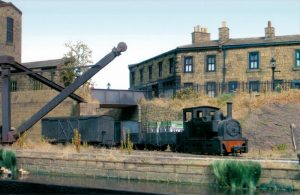 Around the back alleys of Moorton meanders ‘the tramway’, linking the various stations together. From this a short branch connects to the Moorton Canal, where an interchange for stone traffic was created, below street level, at the town basin. To reach the warehouses, at street level, it was necessary to construct a hydraulic wagon lift. By the mid 1930s, when the model is set, the stone traffic has ceased. However, the warehouses served by ‘Bottom Yard’ still provide some traffic for the tramway.
Around the back alleys of Moorton meanders ‘the tramway’, linking the various stations together. From this a short branch connects to the Moorton Canal, where an interchange for stone traffic was created, below street level, at the town basin. To reach the warehouses, at street level, it was necessary to construct a hydraulic wagon lift. By the mid 1930s, when the model is set, the stone traffic has ceased. However, the warehouses served by ‘Bottom Yard’ still provide some traffic for the tramway.
As the track layout is very restricted by the small site, several short trains visit each day delivering coal and raw materials as well as finished goods for transfer to road transport at street level. The yard is also used for storage of spare rolling stock, some of which, in true narrow gauge tradition, has not moved for years! Generally traffic is handled by the Roth Valley Tramway’s Sharp Stewart tram locomotives, although various internal combustion ‘contraptions’ appear from time to time .Also, completely illegally, non-tramway fitted steam locomotives sometimes negotiate the tramway (when the local bobby is not looking!).
Cramped little goods yards were once a common feature of urban railways, but are now just a memory. Perhaps you remember seeing such a scene; if so, we hope will enjoy our representation of the past.
Photos © S Flint
back to top
Netherwood Sidings (O: 7mm scale, 31.5mm gauge)
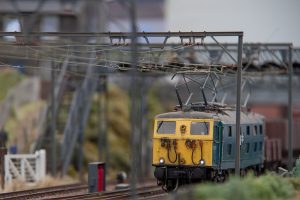 The layout is inspired by the Woodhead line in its final years. It is based on a set of exchange sidings near Sheffield and although the track plan is freelance it incorporates features taken from Rotherwood and Wath. The bridges, in particular are based on the real ones in the Rotherwood area.
The layout is inspired by the Woodhead line in its final years. It is based on a set of exchange sidings near Sheffield and although the track plan is freelance it incorporates features taken from Rotherwood and Wath. The bridges, in particular are based on the real ones in the Rotherwood area.
The scratch built, scale OHLE is the most obvious feature of the layout. The masts are built from brass section and the wiring is to scale, made from 28 gauge nickel silver for the contact wire and 28 gauge copper wire for the intermediate and catenary wires. Some sections of the intermediate wire use Eziline elastic material and it is tensioned by small brass springs. (The prototype wire was not tensioned, but the temperature variations in the loft where the layout is stored make it necessary on the model.)
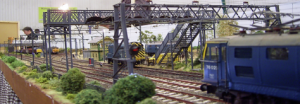 The locos are mainly kit-built; a series of articles in Railway Modeller between Dec 2020 and April 2011 describes how the class 76 electrics were built, and the whole layout was RM’s Railway of the Month in Jan 2016. The layout is controlled by MERG DCC, all diesels have sound units and some have home made smoke units (though these can’t be used in the Barnes Wallis building.)
The locos are mainly kit-built; a series of articles in Railway Modeller between Dec 2020 and April 2011 describes how the class 76 electrics were built, and the whole layout was RM’s Railway of the Month in Jan 2016. The layout is controlled by MERG DCC, all diesels have sound units and some have home made smoke units (though these can’t be used in the Barnes Wallis building.)
Photos © G Clark
back to top
TGB Metal Recyclers (O: 7mm scale, 31.5mm gauge)
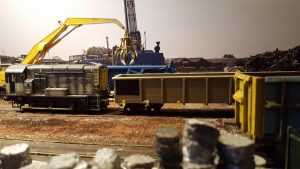 This most unusual layout depicts a late 1990s metal scrapyard somewhere in South Wales and draws its inspiration from the many such industrial units which were, and are, in the area. Most of the rolling stock is scratch built using resin castings prepared from specially drawn plans.
This most unusual layout depicts a late 1990s metal scrapyard somewhere in South Wales and draws its inspiration from the many such industrial units which were, and are, in the area. Most of the rolling stock is scratch built using resin castings prepared from specially drawn plans.
Photos © P Rolley
back to top
Ulvaryd (OO9: 4mm scale, 9mm gauge)
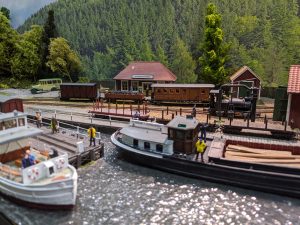 The layout is set in southern Sweden, on the shores of Lake Vättern in Västergötland. It is the lakeside terminus of the Ulvaryd-Mjölltorp Järnväg (the Ulvaryd-Mjölltorp Railway), a 60cm gauge (2ft) railway which connected the small lakeside town of Ulvaryd with the standard gauge line from Skövde to Karlsborg. The railway was built in the early 20th century, inspired by the success of the Helsingborg-Råå-Ramlösa Järnväg. Like the HRRJ, the UMJ began its life with imported French locomotives and rolling stock built by Decauville. Some of these French locomotives are still in service. These were followed by locally built stock, from builders such as Bolinder, Motala and Helsingborg Mekaniksa Verkstad. In reality, the layout is freelance, but inspired by the Swedish 60cm gauge lines that existed until the early 1950s, in particular the HRRJ, the Kosta-Lessebo Järnväg and the Jönköping-Gripenbergs Järnväg. All are now closed, but surviving locos and stock can be seen at Mariefred, on the preserved Östra-Södermanlands Järnväg (www.oslj.nu/ )
The layout is set in southern Sweden, on the shores of Lake Vättern in Västergötland. It is the lakeside terminus of the Ulvaryd-Mjölltorp Järnväg (the Ulvaryd-Mjölltorp Railway), a 60cm gauge (2ft) railway which connected the small lakeside town of Ulvaryd with the standard gauge line from Skövde to Karlsborg. The railway was built in the early 20th century, inspired by the success of the Helsingborg-Råå-Ramlösa Järnväg. Like the HRRJ, the UMJ began its life with imported French locomotives and rolling stock built by Decauville. Some of these French locomotives are still in service. These were followed by locally built stock, from builders such as Bolinder, Motala and Helsingborg Mekaniksa Verkstad. In reality, the layout is freelance, but inspired by the Swedish 60cm gauge lines that existed until the early 1950s, in particular the HRRJ, the Kosta-Lessebo Järnväg and the Jönköping-Gripenbergs Järnväg. All are now closed, but surviving locos and stock can be seen at Mariefred, on the preserved Östra-Södermanlands Järnväg (www.oslj.nu/ )
Photos © A Burnham
back to top
Thomas’s Christmas Surprise (OOish)
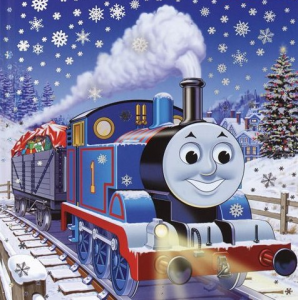 Schhhhh!!! Don?t tell anyone, but it will soon be Christmas on the Island of Sodor. This means that the Fat Controller needs lots of trainee drivers to make sure that all the presents get to the right place.
Schhhhh!!! Don?t tell anyone, but it will soon be Christmas on the Island of Sodor. This means that the Fat Controller needs lots of trainee drivers to make sure that all the presents get to the right place.
Picture © T Stubbs
back to top
Upwell Drove (OO: 4mm scale, 16.5mm gauge)
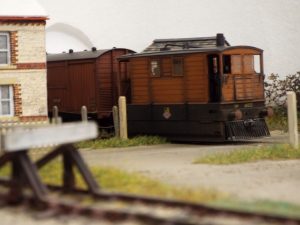 Upwell Drove is set in the Cambridgeshire fens of the nineteen sixties, and is based on the Wisbech and Upwell Tramway. Track is the new Peco code 75 bullhead, with home made PCB points, salvaged from an earlier project. Rolling stock is a mixture of RTR and kit built. Services are operated by J70 trams (Rapido), typical of the Wisbech and Upwell, and a couple of J15?s (Hornby) from Cambridge shed. There is also an 04 tram.
Upwell Drove is set in the Cambridgeshire fens of the nineteen sixties, and is based on the Wisbech and Upwell Tramway. Track is the new Peco code 75 bullhead, with home made PCB points, salvaged from an earlier project. Rolling stock is a mixture of RTR and kit built. Services are operated by J70 trams (Rapido), typical of the Wisbech and Upwell, and a couple of J15?s (Hornby) from Cambridge shed. There is also an 04 tram.
The buildings are from Wisbech and Upwell prototypes and are made of card. The depot office is from Outwell (though all the W&U depots had one), and the tramway waiting shed is a model of the one at Upwell, closed to passengers in 1927. The water tower is made from plastic, using parts from a Wills girder bridge kit, and is inspired by the W&U water tower at Wisbech East. There is also an overgrown and disused cattle dock, based on the one at Upwell. The buildings in village street are based on prototypes in Town Street, Upwell.
Control is DC, using Gaugemaster controllers. The transformer, as well as the drivers for the layout lights and the power unit for the point motors, is built into the underside of the layout.
Photos © A Warren
back to top
West Hill Wagon Works (OO)
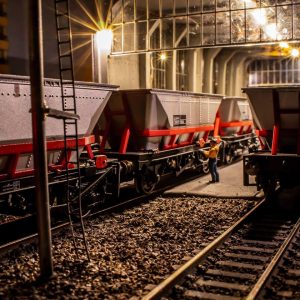 West Hill Wagon Works is a nostalgic tribute to the workings which British Rail once provided for the National Coal Board and which is rarely modelled today. The rolling stock and locomotives seen on the layout vary throughout the day from the late 1960s to the early 1990s, thus giving variation and added interest to the viewers. Short rakes of wagons of different periods arrive in view via a branch line from which they are retrieved by a shunting loco and brought into the works whilst the traction locomotive returns to service. Once in the depot the wagons are moved to repair and refurbishment areas which contain much detail, creating the typical dingy and dirty atmosphere of a working repair yard. After the work is complete, the wagons are shunted back to the storage sidings to await collection. There are also facilities for the essential maintenance of the tractive power.
West Hill Wagon Works is a nostalgic tribute to the workings which British Rail once provided for the National Coal Board and which is rarely modelled today. The rolling stock and locomotives seen on the layout vary throughout the day from the late 1960s to the early 1990s, thus giving variation and added interest to the viewers. Short rakes of wagons of different periods arrive in view via a branch line from which they are retrieved by a shunting loco and brought into the works whilst the traction locomotive returns to service. Once in the depot the wagons are moved to repair and refurbishment areas which contain much detail, creating the typical dingy and dirty atmosphere of a working repair yard. After the work is complete, the wagons are shunted back to the storage sidings to await collection. There are also facilities for the essential maintenance of the tractive power.
The layout has been designed to allow easy photography of the very wide range of rolling stock on display. The operators are always keen to answer questions from visitors about the layout its operation and the rolling stock. One of the operators had a long career at the Derby Railway Technical Centre and has written a book on Rail Vehicle Testing, signed copies of which are available for sale.
Further details at www.facebook.com/WestHillWagonWorks and www.bowerbooks.co.uk
Photo © Chris Bower
back to top
Further Exhibition Information
| Home | Layouts | Traders | For Children |
| Attractions | Catering | Directions |
